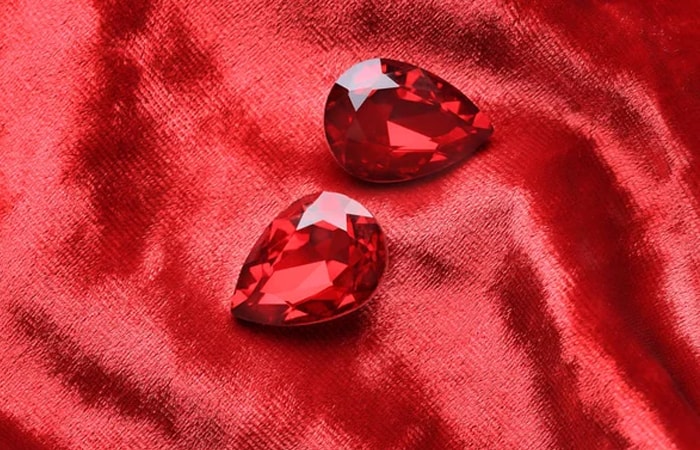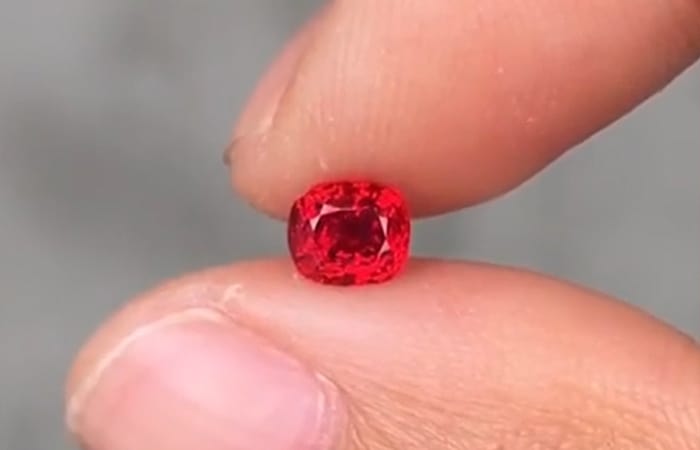Rubies are some of the most sought-after and valued gemstones in the jewelry world, known for their color, luster, and allure. Rubies found in nature are some of the most expensive gemstones you can find today.

But with the increasing demand and popularity of rubies, scientists started to look for ways to develop them. Today, jewelers sell rubies as cultured, created, or synthetic varieties. These stones are often cheaper than their natural counterparts.
Synthetic stones also look identical to natural stones. Their physical properties and chemical composition are also the same. They usually look brighter compared to natural rubies. Gemologists using powerful microscopes are the only ones who can distinguish synthetic and natural rubies.
Although various factors can determine the stone’s market value, your level of satisfaction is the factor that matters the most here. Everyone has unique preferences, and not all preferences will lead to an ideal ruby as defined or set by the industry.
Every stone is a distinct profile of weight, cut, coloration, and clarity characteristics. Even if all stones are cut to similar calibrated specifications, the arrangement and type of clarity characteristics have different stories to tell.
Factors to Consider when Buying Ruby
Most rubies weighing around 1 carat are priced at a minimum of $1,000 per carat. The amount can easily double for rubies that are not heat-treated. The price will also have a steep increase for rubies with good color despite being heated. If you are dealing with ruby stones that are several carats higher, there will be an exponential increase in the price even when the color is not ideal. It is because of the rarity of higher carat weight.
A ruby’s quality is assessed using the similar four criteria used to assess diamonds. But being a colored gemstone, there are no universally accepted standards when it comes to the quality of rubies. The standards are also differently balanced for rubies because the most crucial quality here is the color.
It is very rare to get fine-quality rubies of more than 1 carat although you can commonly find commercial quality rubies in an assortment of sizes. A ruby’s price per carat can significantly increase as its size goes up.
Quality large rubies are rarer. In fact, any untreated quality ruby of more than 2 carats is considered a rare stone. The world-class pieces are those fine quality untreated rubies of more than 5 carats.

Rubies can also be cut into various shapes to expertly showcase the stone’s beauty.
Colors
Even the slightest color difference can already have a significant effect on the price of rubies. As mentioned earlier, the most critical aspect of the valuation of rubies is none other than the color.
The highest quality rubies are of bright red to deep purplish-red color. But it shouldn’t be too dark because it can make the ruby look less bright. There is also a blurred line between a pink sapphire and a light orangish-red ruby.
Clarity
It is extremely hard to find a natural ruby free from inclusions. The truth is that all types of naturally occurring rubies have some imperfections. A ruby’s valuation is heavily dependent on the level of visibility of inclusions.
The visible inclusions can make a ruby look transparent or dull which can lower its value. Needles, or thin mineral inclusions, are often seen in rubies as well. These needles may appear short or long, in groups or distinct.
Inclusions that spread light can boost a ruby’s appearance and make the stone brighter. Needles crossing each other can form a star effect as well which can increase the stone’s value.

Cut
The way rubies are cut can make a significant difference to their sparkle and luster. This can also affect the ability of the stone to showcase various colors in various directions, which is called pleochroism.
Rubies are often found in flat tabular shapes. This is why these stones are typically cut into a cushion or oval shapes. It is also common to use step-cut pavilions featuring rectangular-shaped or concentric square facets when crafting ruby jewelry. The stones can also be shaped using marquise, pear, triangular, emerald, or round cuts.
Rubies can also be cut into different shapes to skillfully display the stone’s beauty. Some cuts highlight specific aspects of a ruby.
- Cabochon cuts bring out a ruby’s asterism with the correct rutile crystal arrangement.
- Step cuts such as Asscher and emerald, and cuts that feature large facets such as the old cushion cut, can maximize the color and sometimes, even the stone’s size.
- Brilliant cuts like pear, princess, or round boost the brilliance and light performance of a ruby stone.
As stated above, pleochroism is a detail that must be considered when trying to achieve the ideal cut of a ruby. It is the appearance of several colors in a stone once this is viewed from various angles. As for rubies, orange or purple is usually the secondary color. Most professional cutters can arrange the pleochroism to complement the stone’s cut.
One more thing to consider when shopping for ruby is to remember that many of these stones are sold in the market already cut in the particular custom style of the country or place of origin.
If you want, you can also have the stone recut although this will cause a loss not just in size but also in carat. In case you prefer a very specific cut, it might limit your choice of available rubies to you.
Carat Weight
Rubies are categorized as fine quality and commercial quality rubies. The former is seldom found weighing over 1 carat. But variants of commercial quality are available in different sizes. This means that a fine quality ruby of 5 carats will cost much more than a commercial quality ruby of the same carat.
Setting
Rubies are red stones best set in yellow and white gold that accentuates and brightens their color. They also look exceptionally charming if set in rose gold or gold.
Conclusion
Good quality rubies will have a combination of rich red color, good cut quality, and good eye-clean clarity with minimal inclusions.



